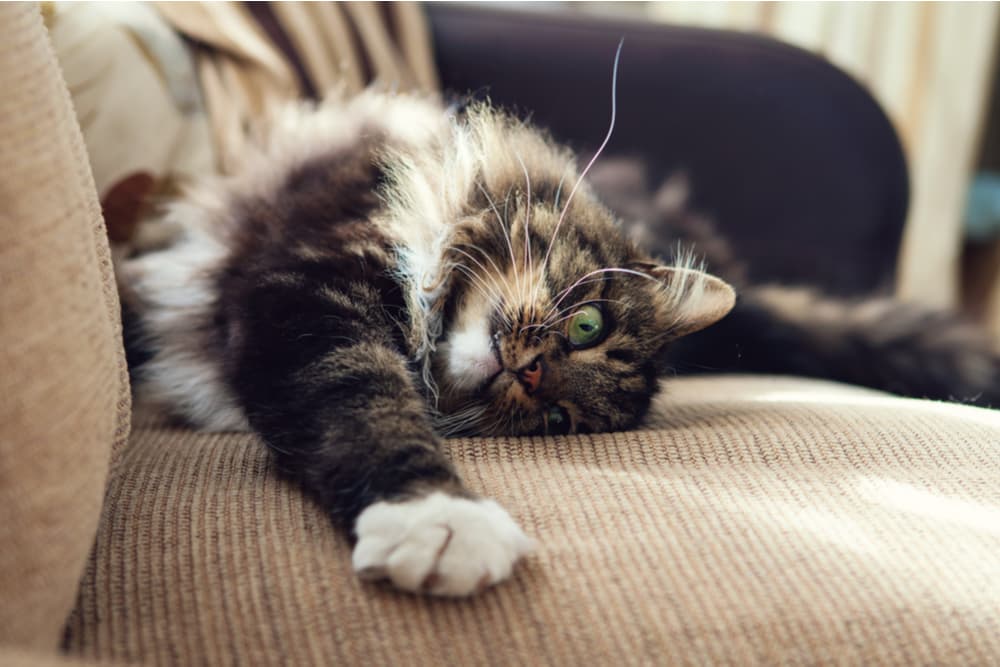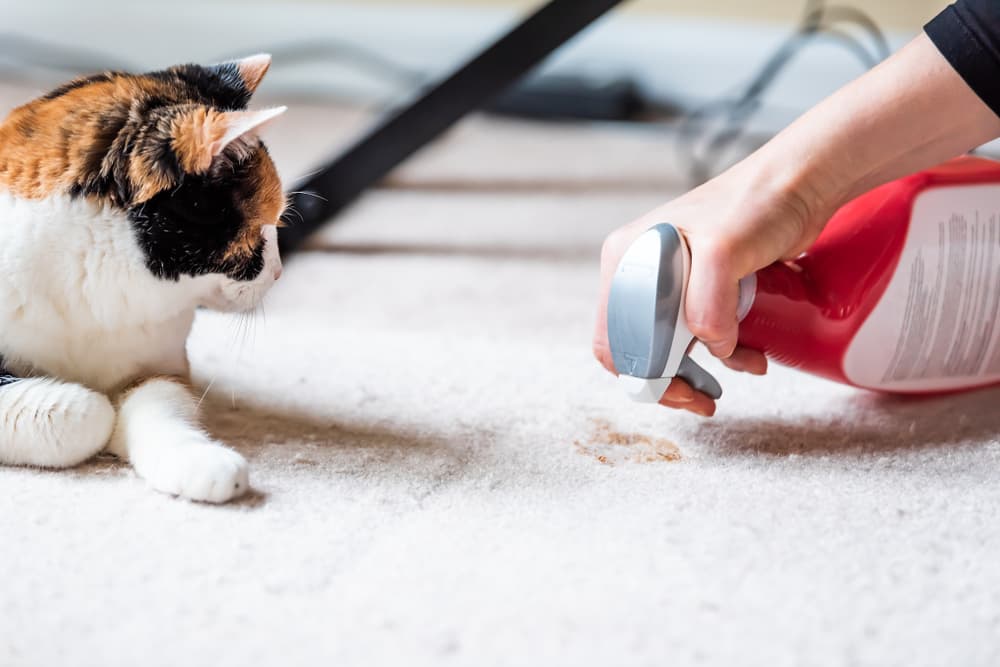How to Clean Cat Pee: Every Step You Need to Take

Cat pee can be tough to clean, and even if you’ve eliminated the stain, the horrible smell can still linger. This can result in a cat who keeps returning to the scent to re-mark her territory. Eventually, you may not know how to stop your cat from peeing everywhere.
Inappropriate elimination (going outside the litter box) is a top reason why cats are relinquished to shelters, released outdoors, and euthanized, says Dr. Sasha Gibbons, an associate veterinarian at Just Cats Veterinary Hospital in Stamford, Connecticut. Luckily, she says, “Many times the route of the problem is fixable.”
If you love your kitty but dislike that distinct and pungent cat pee smell, consider some of the following expert-recommended guidelines for how to clean cat pee.
Why It’s Important to Clean Cat Pee

The most important reason for promptly cleaning cat urine stains is to remove the odor, says Misty Hampton, a shelter associate with Cat Adoption Team in Sherwood, Oregon. “It is the odor that causes cats to recognize that area as a latrine.”
Some of this behavior is tied to natural cat behaviors. Cat pee contains proteins that are used to mark territory in the wild, says Gibbons. “If cat urine is not properly cleaned, these scents will attract the cat to keep coming back to the area, and may even entice other animals to go in the same spot.”
Cleaning up urine quickly and completely prevents it from soaking deeply into furniture, carpets, and other items, says Hampton. “Once urine does soak in, it may be impossible to eliminate the odor.” Even traces of leftover urine can cause a cat to re-mark the same area.
And the longer cat urine sits, the smellier it becomes. As the bacteria in urine decomposes, it emits a stale, ammonia-like odor and eventually releases the same type of compounds responsible for the pungent smell of skunk spray, according to the Office for Science and Society at McGill University in Montreal, Canada.
Cleaning Cat Pee: Common Mistakes

If you’re cleaning and still not getting good results, you may be making one of the following common mistakes.
Not using a black light. Just because cat urine isn’t visible, doesn’t mean it’s not there. To eliminate all traces of cat pee, Gibbons recommends using a black light—an ultraviolet light that makes it easier to detect the urine. Cat pee that’s exposed to black light glows in the dark, making it easier to spot and clean.
“Many owners do not realize the importance of the black light and unfortunately will fail to get all of the urine, resulting in further accidents,” says Gibbons.
Not using an enzyme cleaner. “Many owners don’t realize the importance of enzymatic cleaners and simply clean urine with soap or vinegar,” says Gibbons. Pet enzyme cleaners are often recommended because they permanently break down the acid—and the odor—in urine. Enzyme based cleaners are available at most places you purchase other pet products.
Rubbing a stain. Vigorous rubbing can cause stains to spread and travel deeper into fabrics, making them even more difficult to clean. The Smithsonian Museum Conservation Institute advises against rubbing because the friction can corrode or rip fabric. Instead, follow the instructions on the bottle of cleaner.
Using ammonia-based cleaners. The recognizable and familiar cat pee smell originates from ammonia. When the urea in cat urine decomposes, it creates ammonia. So, using an ammonia-based cleaner to clean cat pee is counter-productive. “Using ammonia to clean up cat pee is inviting the cat to re-soil the area,” says Hampton.
How to Clean Cat Pee

Cleaning up soiling accidents as soon as you notice them can prevent odors from permanently setting in, making it less likely that your cat will revisit the area.
For each of these surfaces and fabrics, our experts recommend using a pet enzyme cleaner as your primary cleaning solution. Products vary by manufacturer, so follow label directions for best results.
How to Get Cat Pee Out of Carpets
To clean up cat pee from carpets, the Ohio State University College of Veterinary Medicine (OSU) and other experts recommend a variation of the following:
Step 1: Blot the area with a towel to absorb most of the liquid.
Step 2: rinse the area with a soap and water solution.
Step 3: Suction it with a carpet cleaner or wet vacuum, and re-blot the area.
Step 4: After this process, liberally apply an enzymatic cleaner that’s suitable for use on carpets, then blot the excess.
How to Clean Cat Pee Off of the Couch
The process to clean up cat pee from couches is similar to that of cleaning carpets, says Gibbons. Here are the steps she recommends.
Step 1: Start by using a black light to locate the urine.
Step 2: Thoroughly saturate the spot with an enzymatic cleaner that is safe for fabrics.
Step 3: Dab the excess stain cleaner away.
Step 4: Repeat until nothing can be identified by the black light.
Cleaning Cat Pee on Wood Floors

To clean cat pee out of wood floors, OSU recommends the following cleaning steps:
Step 1: Blot up excess urine before proceeding to clean it. This step is especially important for hardwood floors since liquid can damage it.
Step 2: Saturate the spot with an enzymatic cleaner that is safe for hardwood floors.
Step 3: Dab the excess enzyme cleaner with a paper towel.
How to Clean Cat Pee Out of a Mattress
If your cat pees on your bed, it can be extremely frustrating. Getting the stain and smell out is the best way to prevent your cat from marking the area again. Similar to cleaning a carpet, here are steps to get cat pee out of a mattress, according to Gibbons.
Step 1: Locate the stain on the mattress with a black light.
Step 2: Thoroughly saturate the spot with a fabric-safe enzymatic cleaner.
Step 3: Dab any excess away and repeat until nothing can be identified by the black light.
Step 4: You may want to flip your mattress and use a black light to see if any or the urine has seeped through to the other side. If so, repeat the same steps on this side of the mattress.
How to Get Cat Pee Out of Clothes

Cats may mark clothing if it is lying on the floor or if your cat likes to get into the laundry basket. To get cat pee out of clothes, try the following steps.
Step 1: Spray the soiled area with an enzyme cleaner for cat urine.
Step 2: Launder it immediately, separating it from other clothes. Gibbons recommends placing one cup of enzymatic cleaner in the washer with your regular amount of laundry detergent and washing on a deep clean setting.
Step 3: Repeat until no odor and stain is detectable on the clothing.
Note: Allow clothing to air dry instead of using the dryer. Heat from the dryer can trap any remaining odors into clothing.
Best Products for Cleaning Cat Pee

Some people may suggest spraying a vinegar and water mixture to stains, then once dry, sprinkling it with baking soda. The thinking is that baking soda works chemically to neutralize odors, while the acid in vinegar neutralizes the alkaline in dried urine and kills bacteria. However, this method will not be effective at cleaning up cat urine or preventing further elimination in that area.
Most products formulated for use on pet urine stains and odors are enzyme-based, and it’s what our cat experts recommend. Enzyme cleaners work promptly to break up the ammonia and carbon dioxide in urea, both of which evaporate quickly. Enzyme cleaners break down the proteins in urine that cause cats to continue to mark the same spot, stopping the problem before it gets worse.
Do Air Fresheners Help?
Air fresheners help mask odors that the human nose can detect. To prevent future urine marking from occurring, however, it’s essential your cat can’t smell the urine either, says Gibbons.
Cleaning Products to Avoid
Be careful with household cleaners, as some contain chemicals that are dangerous around pets. Only use cleaning products formulated for use around pets, like a cat urine cleaner or cat urine remover.
Additionally, products with heavy fragrances can irritate a cat’s lungs, says Hampton. If in doubt about any product, check with your veterinarian or ASPCA Poison Control for guidance.
As mentioned above, avoid using ammonia-based products to try to clean cat litter. The ammonia will only make the smell worse and cause the cat to keep coming back to that spot.
How to Prevent Litter Box Accidents

It’s much easier to prevent accidents than it is to clean them up. Here are a few expert-recommended techniques to help you help your cat not use your home as a bathroom.
Rule out a health issue. A cat who experiences discomfort or pain in the litter box will avoid using it. Pain can be caused by urinary tract infections, urinary stones or crystals, or be related to defecation. Have your cat thoroughly checked out by your veterinarian to make sure he is healthy.
Rule out behavioral issues. “If you have a cat who pees outside the box, your best bet to resolve it is to find out what is causing it,” says Hampton. Cats who spray urine may use it to soothe themselves when they are upset.” Cats can get upset about even minor household changes including new noises or even new furniture.
You may want to check with a certified cat behaviorist or your veterinarian to determine the source of your cat’s behavior. Always avoid punishing or scolding her, as this will only make things worse, says Hampton.

Keep a tidy litter box. Maintaining a clean litter box reduces the build-up of ammonia, which is the source of the pungent smell in cat urine. “Boxes should be scooped at a minimum of daily and thoroughly disinfected at least monthly,” says Gibbons.
Add additional litter boxes for multi-cat households. As a general rule, you should have one litter box per cat, plus one extra, says Gibbons. “For example, if you have two cats, you should have one litter box for each of them, and one additional litter box, totaling three.” Keep each of them clean so your cat always has an acceptable place to go.
Experiment with different types of litter and boxes. Some cats have distinct preferences for certain types of litter (like clay, paper, corn, and walnut), says Gibbons, “And it can take trial and error to determine which one is right for that individual cat. Similarly, some cats prefer uncovered litter boxes to covered boxes and vice versa.”
If your cat is a senior who has trouble with mobility, set up the litter box for easy accessibility.
Consider location. Litter boxes should be in secure areas where cats will not feel threatened by loud noises, people, or other animals, says Gibbons. Also, separate the boxes. “In the eyes of a cat, three litter boxes in a row count as one giant litter box, and not three boxes,” she adds.
When to Contact a Veterinarian

If accidents still occur after you’ve followed these guidelines, your cat may have an underlying medical issue, says Gibbons. “Cats are prey animals in nature and are good at masking signs of illness, so even if the cat is acting fine otherwise, this still warrants evaluation by a veterinarian.”
Urinary issues can be serious and sometimes even life-threatening in male cats, Gibbons says. “Any time a male cat is urinating outside the box, and especially if there is a change in the size, color, or frequency of urination, he should be evaluated right away,” she says.
These same guidelines also pertain to females and can indicate an underlying medical condition that requires a veterinary visit. “Luckily, the majority of the time, it is not an emergency issue in female cats.”









